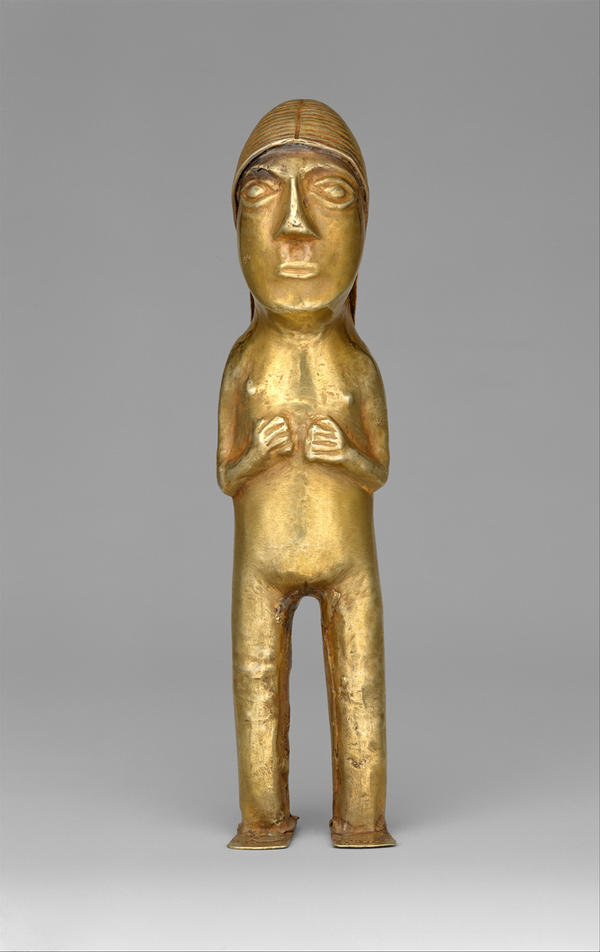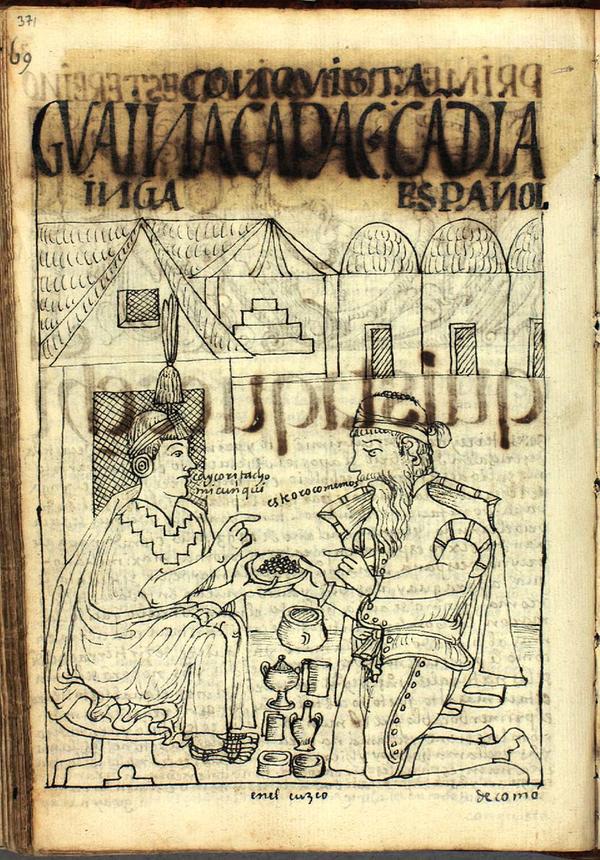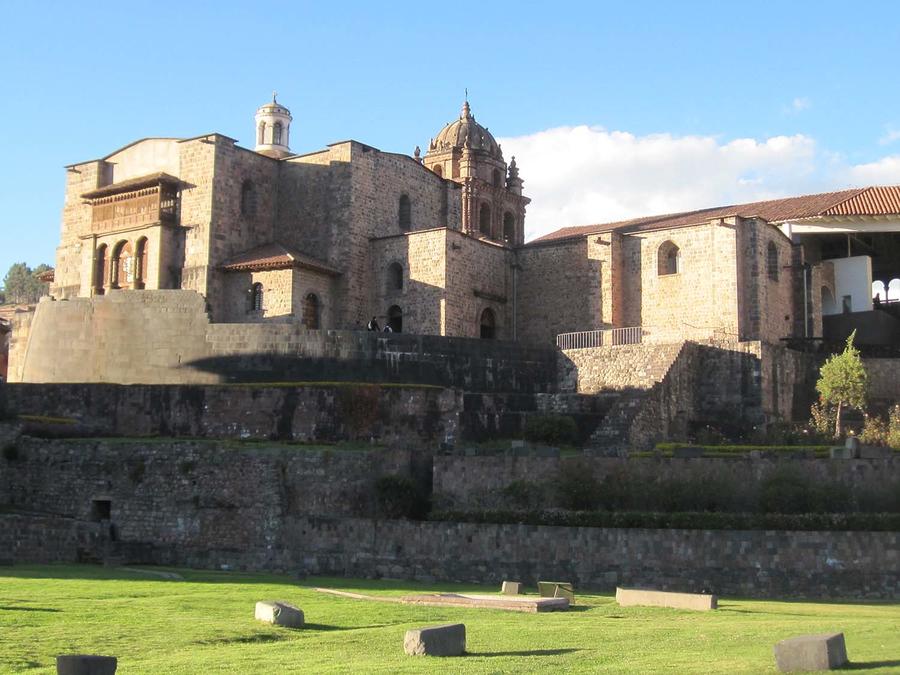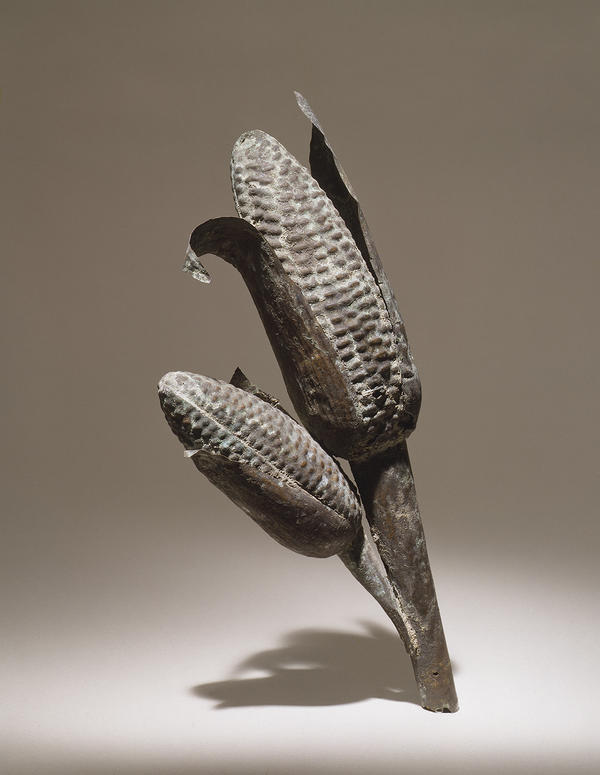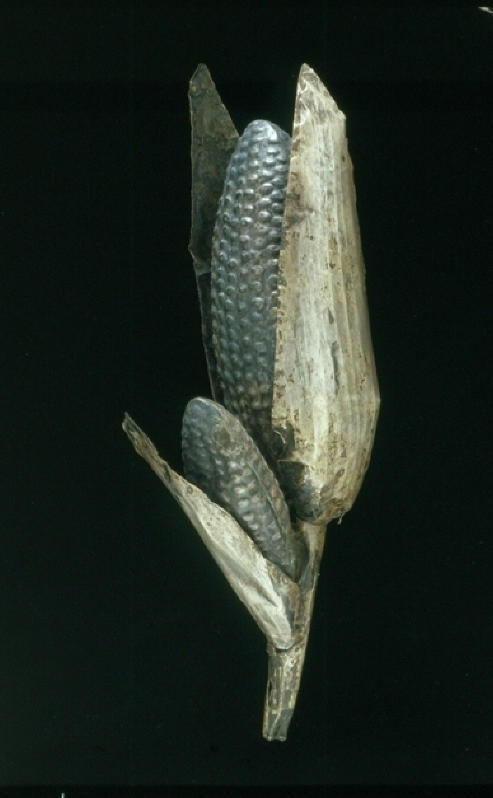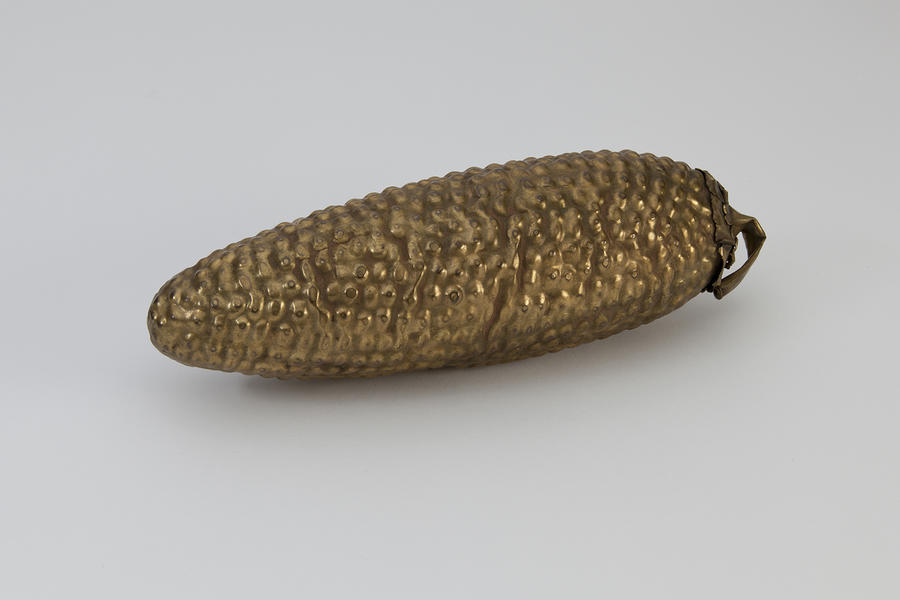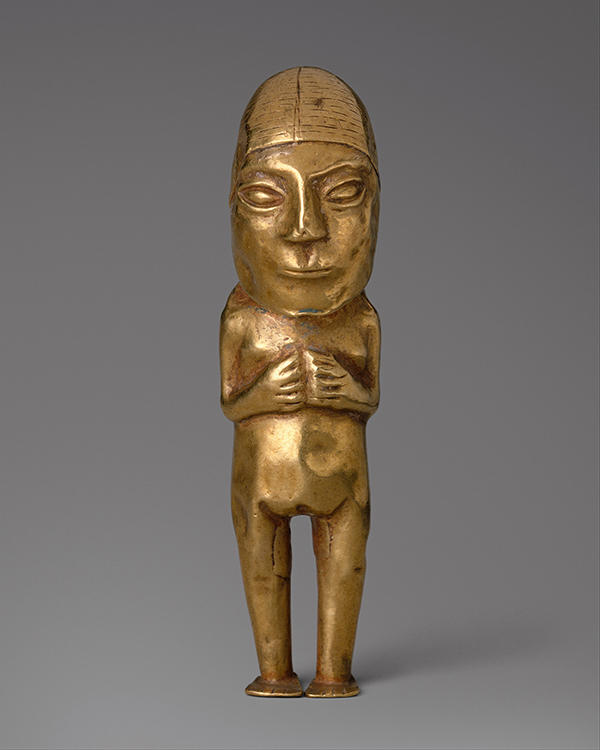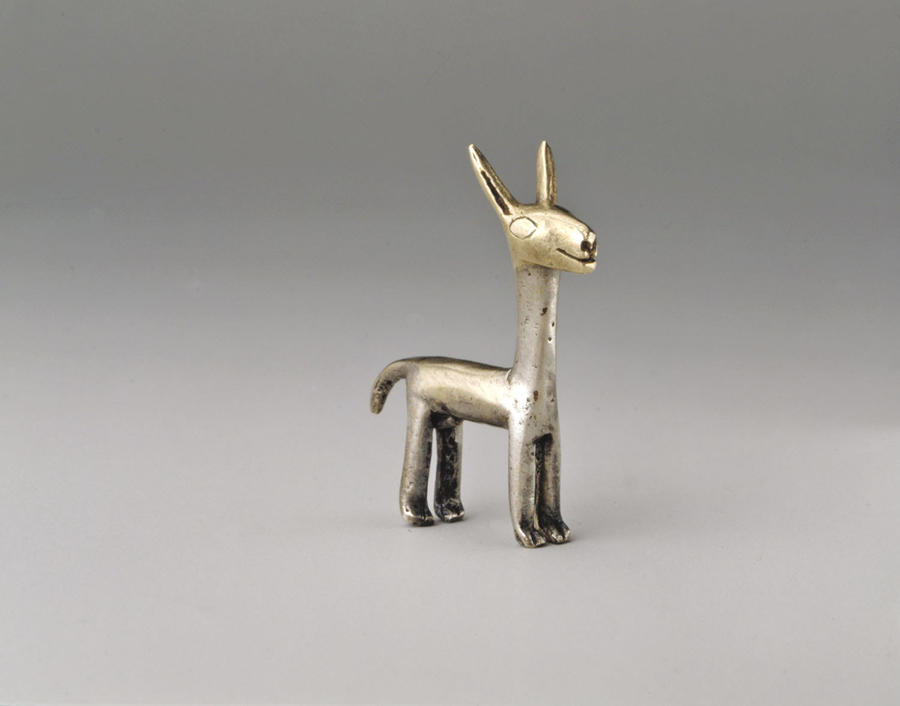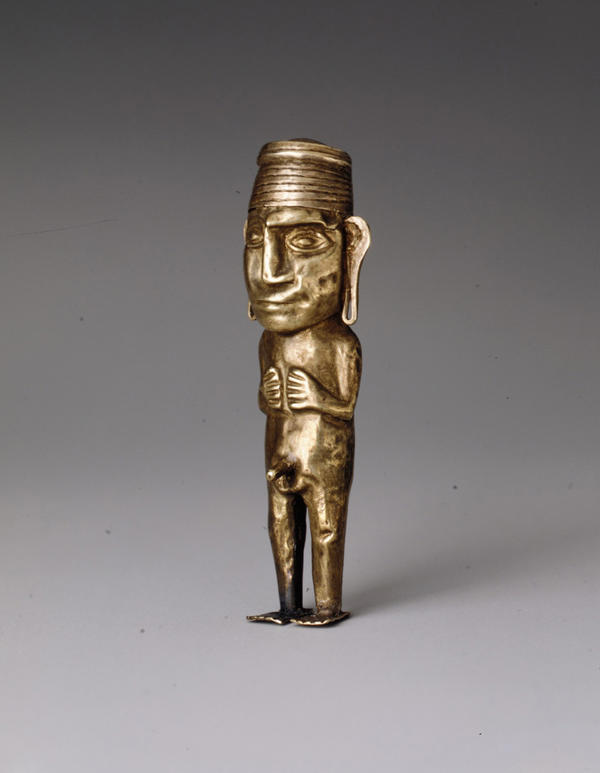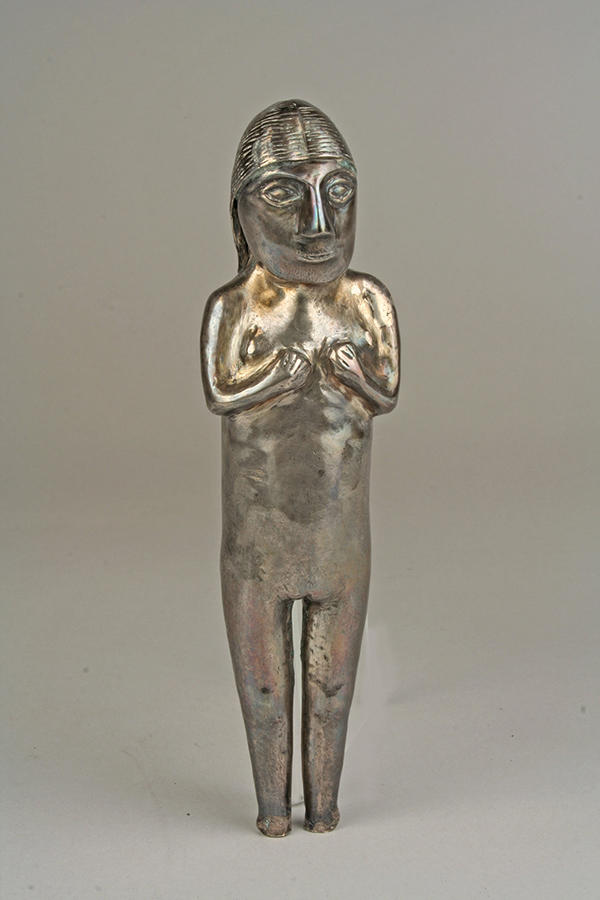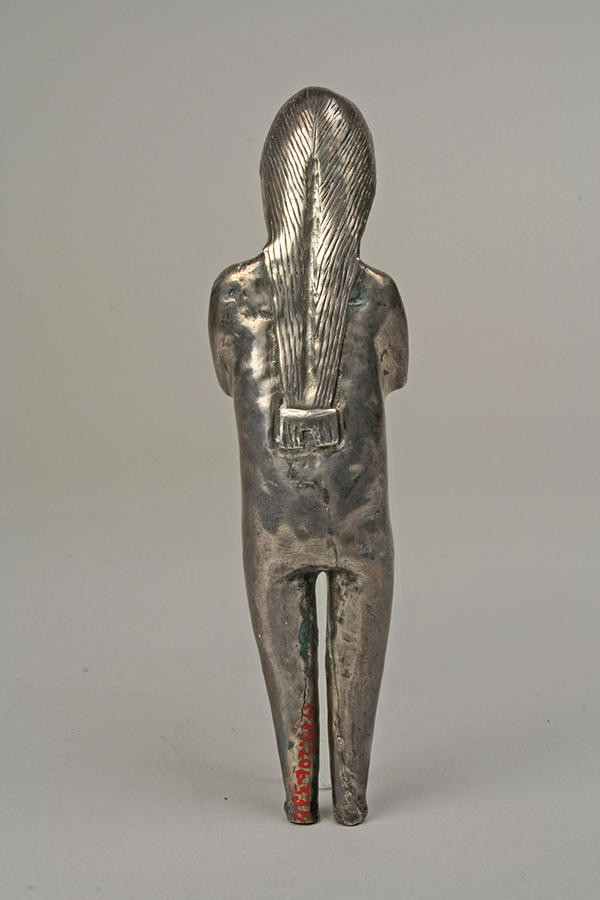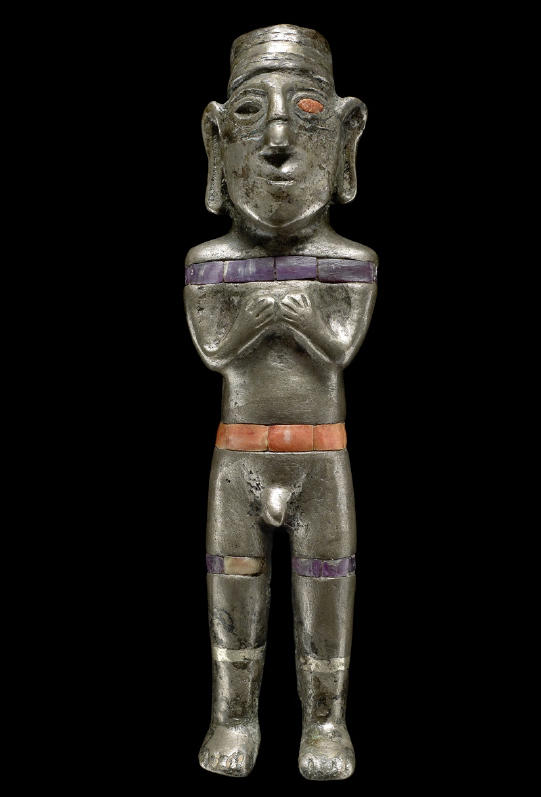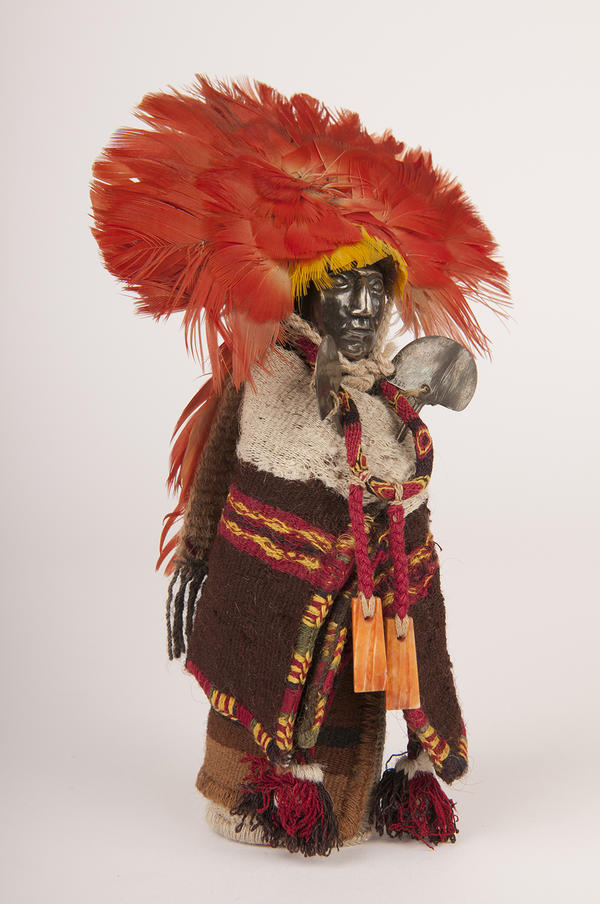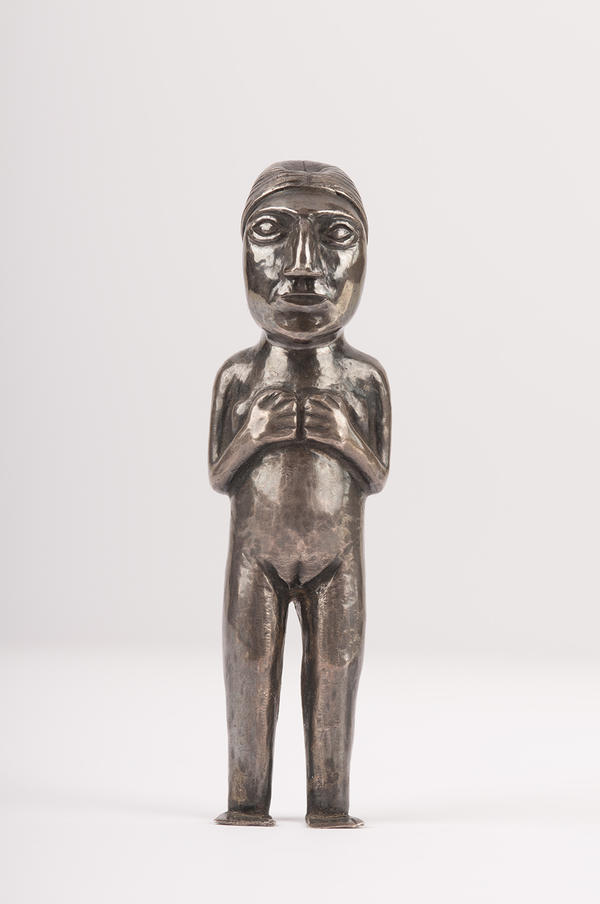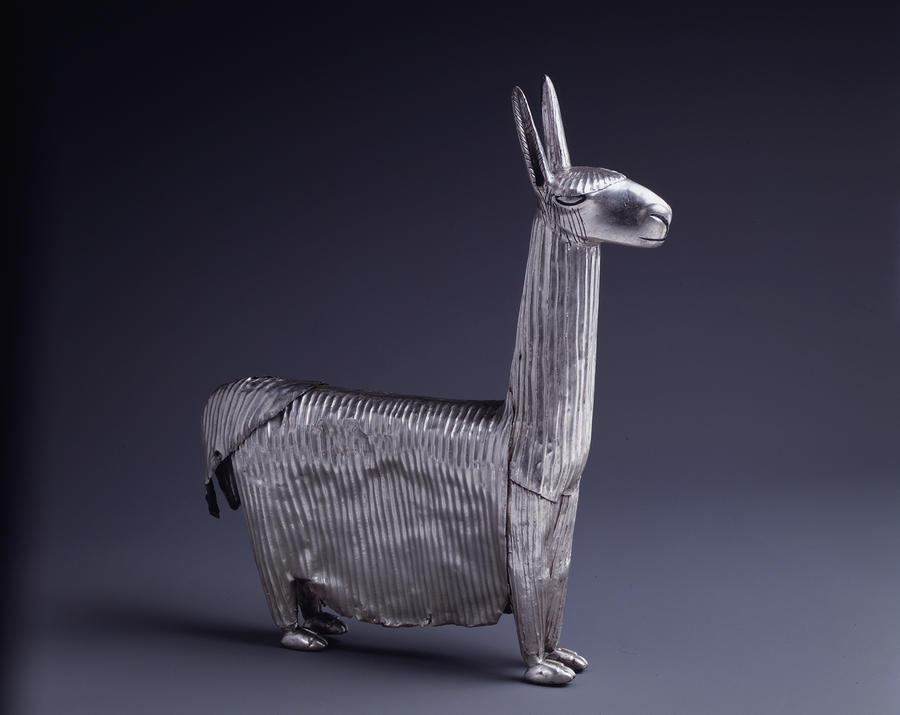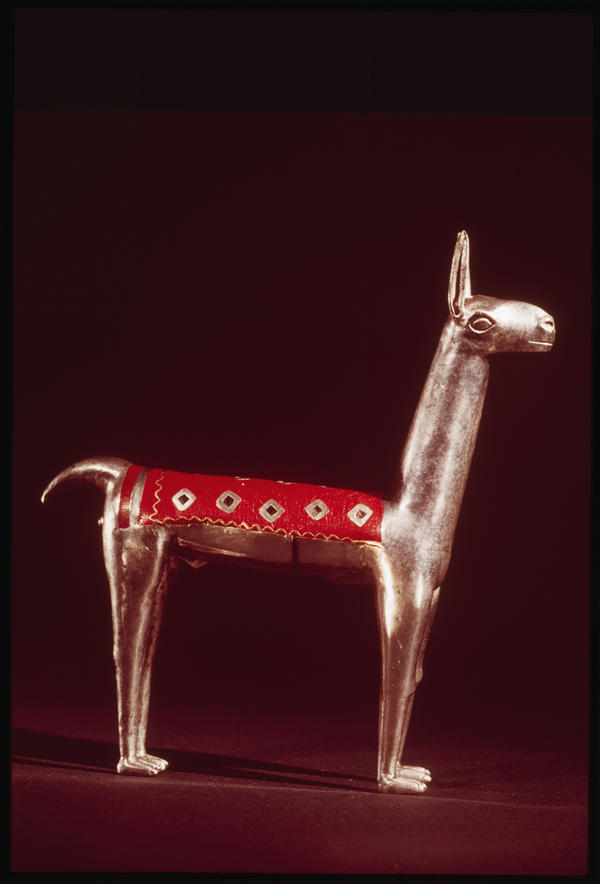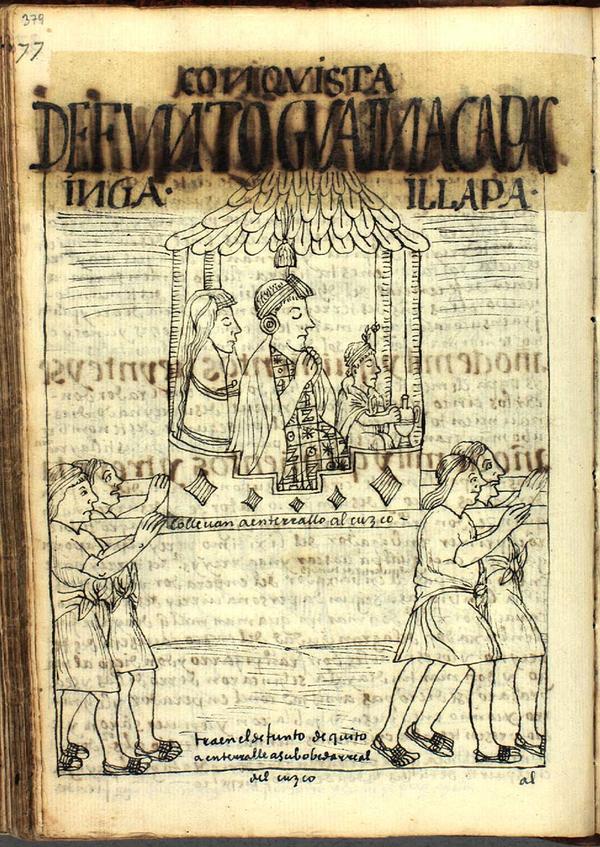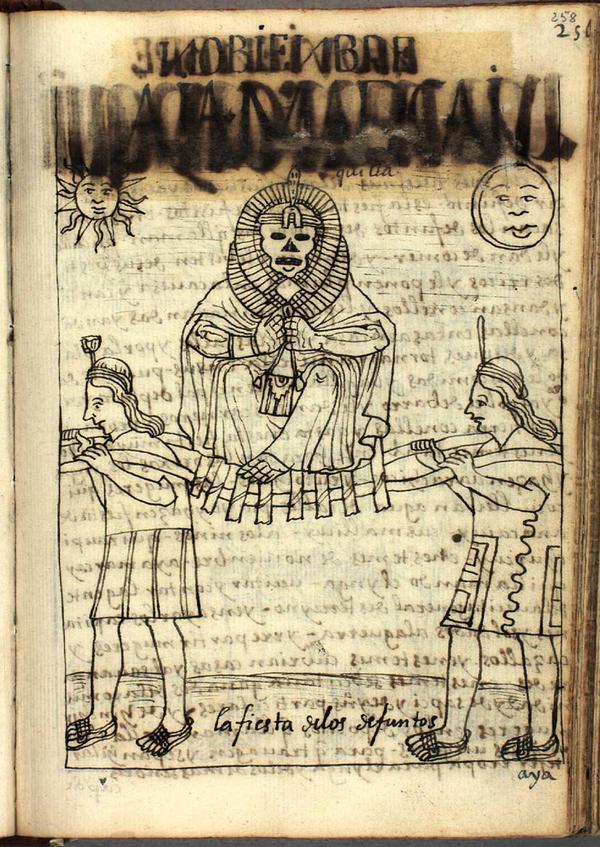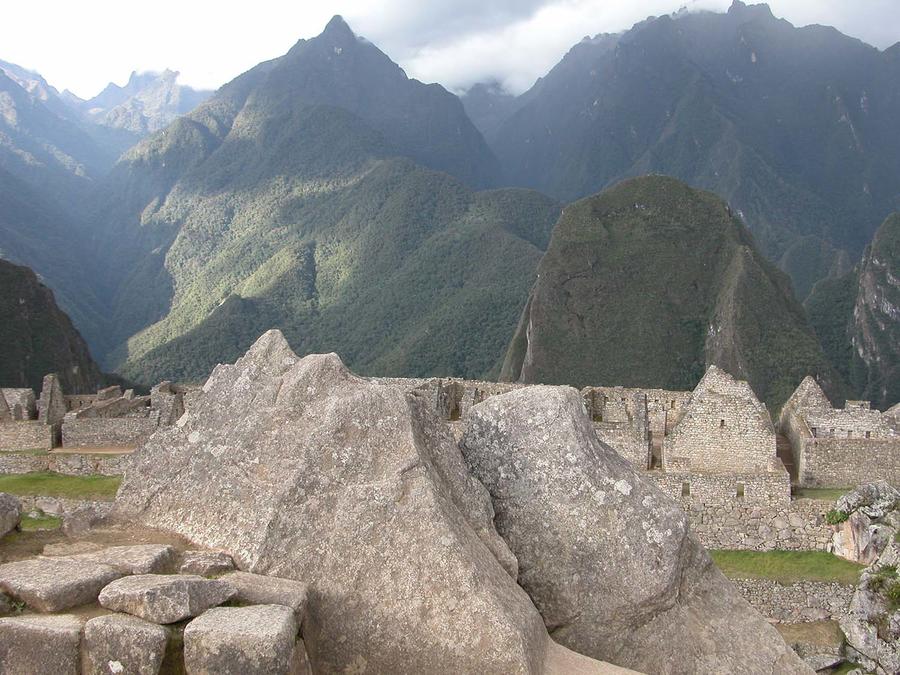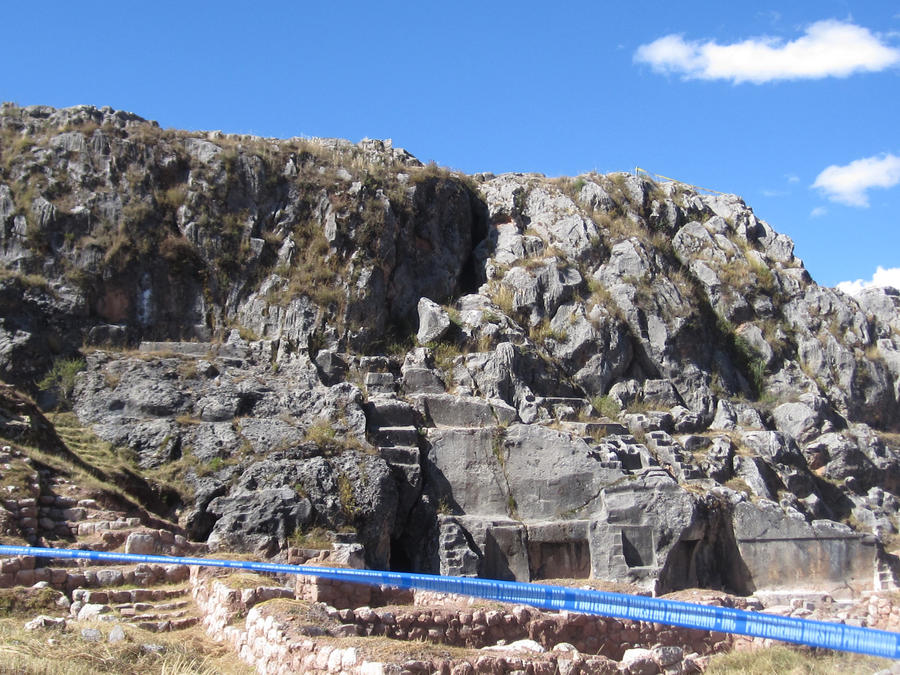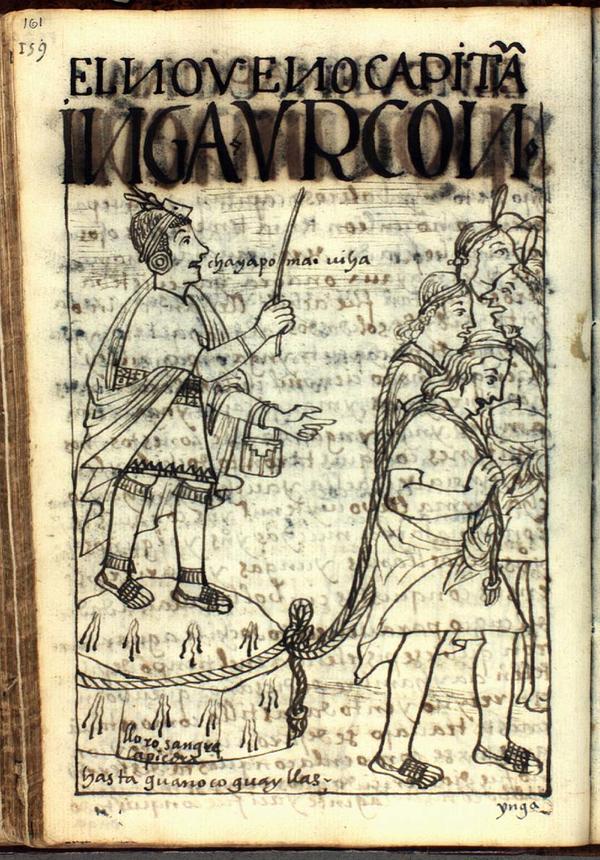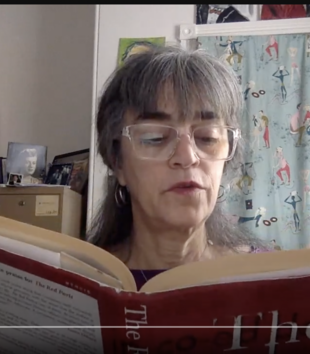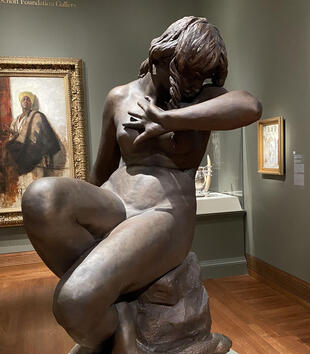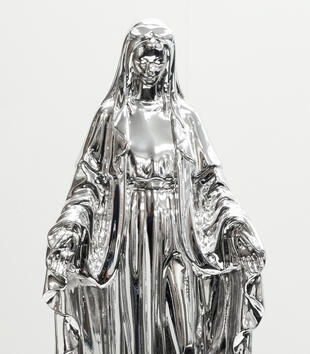Metalworking occupies a unique place within Inca artistic production. A surprising percentage of the surviving works in this high-value medium might be considered anthropomorphic or zoomorphic, making them singular in the Inca artistic corpus, famed for its avoidance of flora and fauna. Descriptions by Spanish chroniclers suggest that many more anthropomorphic and even perhaps "naturalistic" works once existed. This essay thereby grapples with the following two questions: why did the Inca approach metal so differently from other sculptural media, most notably stone? And how do we square descriptions of Inca metalwork’s "naturalism" in European chronicles with what we might describe, at best, as anthro- or zoomorphic forms in the surviving Inca corpus? I draw on evidence of precious metal sculptures found in archaeological contexts, recent research on the Berlin museum "Inca" corncob, and an analysis of the chroniclers’ writings to address the prevalence of anthropomorphism in Inca gold and silver production and argue that, for the Inca, the materials with which they worked shaped the representational modes they employed. Rather than inert substances awaiting the intervention of the artisan, materials could be numinous agential entities in their own right. Stone, the Inca material par excellence, possessed inherent agency, in that the Inca perceived stones as living entities; these were often left entirely unhewn. In contrast, gold, with its malleability and potential for fluidity, was not considered a living being in its own right, but instead metallic effluvia, the tears of the powerful sun deity.1 As tears, gold was charged with the power of this important deity but was not in and of itself living. This distinction between gold as tears of the sun, and stone, with its own intrinsic vitality, explains the contrasting ways in which the Inca worked the two materials: metals were sacred but not living and, due to their fluidity, had no "natural" state or shape. Thus, unlike stone, they could and perhaps should be shaped into anthropomorphic forms without betraying their own essential nature. To grasp this essential difference between metal and stone, it is necessary first to reframe "naturalism" against Spanish chroniclers’ descriptions and to excavate the ways in which Spanish sources have largely and perhaps unavoidably shaped our perception of Inca metalwork.2
The Myth of Naturalism
Even as the Spaniards’ destructive hunger for gold eliminated the vast majority of Inca works in metal, the writings of the Spanish conquistadors supply our primary source for understanding Inca craftsmanship and Inca conceptualization of precious metals. The conquistadors’ obsessive quest for gold weaves its way through all of their writings. Indigenous Andean chronicler Felipe Guaman Poma de Ayala captures this hunger in a drawing of a fictitious meeting between Inca emperor Huayna Capac and Pedro de Candía, the first Spaniard to reach Peru (Fig. 2). In Guaman Poma’s drawing, Huayna Capac, gesturing towards some golden granules, asks Candía in Quechua, "Cay coritacho micunqui?" (Do you eat this gold?), to which Candía affirms in Spanish, "Este oro comemos" (We eat this gold).3 Although Guaman Poma uses this illustration to make a pointed commentary rather than to express lived reality, his image is indicative of the kind of "hunger" the Spaniards felt for precious metals.
In reading the colonial accounts, the Spanish mania for precious metals is both a blessing and a curse. Although their interest in gold and silver led to frequent references to Inca metalwork in the chronicles, it simultaneously resulted in the destruction of almost all Inca metalwork, and inflected the nature of their descriptions of precious metals, which generally emphasize quantities of metals over detailed meditations on the physical appearance of gold and silver objects. The chronicles are neither disinterested accounts nor uncomplicated documents: many chroniclers wrote years after the events they described, and they had diverse motives for either exaggerating the quantities and qualities of the materials they discovered or for disguising them. As S.K. Lothrop notes, early writers might wish to be vague or even disingenuous about the quantities of precious metals acquired by the conquistadors as to avoid paying the king his full quinto royal, or royal fifth.4 In contrast, chroniclers writing long after the fact might suffer from the vagaries of their own memories or the unreliability of their sources, and might intentionally exaggerate Inca wealth either because, as conquistadors, they wished to emphasize the magnitude of their service to the crown or, in the case of chroniclers come later to Peru, they wished either to emphasize the greed of the Inca or the Inca’s imperial magnificence. Furthermore, Carolyn Dean reveals the indigenous agency and deception in these accounts, given that the chroniclers often relied on faulty information provided by indigenous informants exaggerating their descriptions of precious metals in order to manipulate the Spaniards.5
While scholars must acknowledge the idiosyncrasies of the chronicles as historical documents, they still remain the sole written source for understanding much of the Inca metalwork now lost to the world. The same individuals who melted down the majority of Inca gold and silver nonetheless offer the only descriptions we have of these materials. The earliest chronicle describing the conquest of Peru, La conquista del Perú llamada la Nueva Castilla (1534), is attributed to Cristóbal de Mena, a member of Francisco Pizarro's expedition. Mena is a useful source because he was present at many of the events of the conquest.6 Unfortunately he provides little detail in his descriptions of Inca metalwork. Although he does mention many gold and silver vessels of various kinds, and occasionally praises gold and silver objects as muy hermosas (very beautiful), Mena primarily speaks of gold and silver in terms of weight and quantity. The forms and cultural importance of gold and silver remain secondary to his account.7 Mena is nonetheless the first to describe great sheets of gold adorning buildings and offers intriguing visions of ritual within what is likely the Q’oricancha (Fig. 3), the most important Inca temple, which was dedicated to the sun and which would later become central to conceptualizations of the glories and opulence of Inca metalwork. Mena described a woman wearing a golden mask who sat fanning mummies against flies and dust; the demand that the conquistadors remove their shoes before entering the precinct; Atahualpa's request that the conquistadors not take the gold belonging to his father, here called "the Cuzco," whose mummy rested within the temple.8 Mena gives a single hint of the anthropomorphic and zoomorphic sculpture other chroniclers would describe within this precinct, writing with tantalizing brevity that, "before Atahualpa died he had ordered that a shepherd with sheep of gold be brought."9
Later descriptions build on Mena’s brief account of a golden "sheep," most likely a llama, and supply descriptions of Inca silver and gold that emphasize the naturalism and life-like qualities of this work. It is from these accounts that scholars have built a picture of Inca metalwork as highly mimetic.10 For example, Pedro Sancho de la Hoz, one of Pizarro’s secretaries, lists the Inca metalwork the Spaniards melted down, writing:
And among other singular things were very much to be seen four very large rams of fine gold and ten or twelve female figures, of the size of the women of that land, all of fine gold so beautiful and well made as if they were living. These they held in such veneration as if they were rulers of the entire world and were living, and they dressed in them in beautiful and very fine clothing, and they adored them as goddesses, and they fed them and spoke with them as if they were women of flesh.11
Descriptions like Sancho’s, in which he characterizes the female sculptures as "beautiful and well made as if they were living" (emphasis added) seem to suggest a high level of mimesis in the Inca metalwork seen by the Spaniards.12 References to naturalism are particularly prevalent in chroniclers’ representations of the golden garden of the sun at the Q’oricancha. They form a picture of a shimmering garden planted with gleaming metal cornstalks, strewn with gold nuggets in place of dirt, grazed by burnished llamas, and tended by resplendent, motionless shepherds.13 Although a number of chroniclers describe the garden, the most evocative recounting comes from Inca Garcilaso de la Vega.14 Garcilaso was born in 1539, and as such did not have first-hand knowledge of the conquest or of the pre-conquest era. As the son of a conquistador and an Inca princess, he drew on the memories of knowledgeable individuals, both Inca and Spaniard, as well as on the narratives of prior chroniclers, to write his account:
. . . that garden that now serves as the vegetable garden for the convent [Santo Domingo—the Dominican monastery built on top of the Inca temple], was in the time of the Incas a garden of gold and silver, like the ones that they had in the royal palaces of the rulers, in which there were many grasses, and flowers of diverse kinds, many small plants, many great trees, many animals large and small, wild and domestic, and crawling things . . . like snakes, lizards, and snails, . . . butterflies and birds . . . everything in its place, so as to best counterfeit the natural thing that it mimicked [q mas al propio cōtrahiezesse a la natural q remedaua].
There was a great cornfield, and the grain that they call Quinoa, and other legumes and fruit trees with their fruit, all of gold and silver counterfeiting nature [cōntrahecho al natural] . . . there were also large figures of men and women and children cast of the same [gold and silver] . . . 15 (emphasis added)
As he alludes to, Garcilaso had also written detailed accounts of the gardens of gold and silver in the royal palaces:
They planted in them [the gardens] all the beautiful and pleasing trees, beds of fragrant and beautiful flowers that there were in that kingdom . . . Among these and other great things they made corn plants, counterfeiting nature [contra hechos al natural] with their leaves, cobs, and stalks, with their roots and flower. And the hairs that the cob puts out were of gold, and all the rest of silver, soldered one to another. And they did the same in the other plants, so that the flower, or whatever other yellowish thing [there was] they imitated it [la contra hazian] in gold and the rest in silver. There were also small and large animals, imitated [contra hechos] and cast of gold and silver . . . There were all kinds of birds, some placed among the trees, as if they sang, others as if they were flying and sucking the honey from the flowers. There were venomous snakes and fallow deer, lions and tigers and all the other animals and birds that grow in that land, each thing in its place, in order to better copy nature [como mejor cōtrahizesse a lo natural].16 (emphasis added)
These descriptions of glittering gardens raise the question: what did sixteenth-century European and mestizo observers like Sancho and Garcilaso mean when they report the "counterfeiting" and "copying" of nature, the "lifelike" qualities of Inca metalwork reproducing plants, animals, and human beings? Sancho construes the female figures as "well made as if they were living" (bien hechas como si estuvieran vivas), while Garcilaso repeatedly uses the Spanish "contrahacer" (counterfeit) along with references to "a lo natural" (after nature or like nature) and a single use of "remedar" (mimic). Although for twenty-first-century readers the term "counterfeiting" may have a negative connotation, in the sixteenth century, as Peter Parshall explains, the term "had a special place in the Renaissance lexicon of terms having to do with identity and representation. Most striking is its insistent claim to truth, implicitly or explicitly a truth based upon the testimony of direct witness . . ."17 Thus for an educated, elite writer like Garcilaso, Inca metalwork conveyed "truth" in its representations of nature, a truth akin perhaps to sixteenth-century European woodcut botanical illustrations, which might similarly be referred to as "counterfeiting" nature, and which similarly made claims to faithfulness in reproduction.18 Perhaps Garcilaso had botanical prints like those in Leonhard Fuchs’s De historia stirpium (On the History of Plants) (1542) in mind when he wrote, "they imitated many trees and other lesser shrubs in gold and silver, lifelike, with their leaves, flowers, and fruits: some that had begun to open, others half ripe, others completely perfected in their size" (my emphasis).19 Fuchs’s botanical prints, like Garcilaso’s Inca gardens, combined in the illustration of a single plant the various moments of the plant’s life cycle, its buds, flowers, fruits, and leaves all depicted simultaneously, defying the laws of nature in order to give a "complete" experience of the plant.20 This complete image allowed Fuchs to present ideal specimens rather than individual exemplars, making an argument about the medicinal value "of a species as a whole that would be valid for all instances of the same species."21 The gold and silver plants and animals in Garcilaso’s precious metal gardens similarly exhibit all the different moments of the plants’ lifecycles. Were the Inca evoking the abundance and richness of the natural world? Or was Garcilaso evoking the conventions of description in early modern European botanical illustration so as to praise and elevate this work to a European standard?
If Garcilaso’s Inca gardens present an ideal facsimile of nature in all its typological and temporal diversity, frozen for perpetuity in silver and gold, other chroniclers’ conceptualization of the "naturalism" of the Inca gardens is more ambiguous. Unlike Garcilaso, Pedro Pizarro, a relative of Francisco Pizarro who was a seventeen-year-old page when the conquistadors captured Atahualpa at Cajamarca, would actually have been able to personally observe the Q’oricancha garden. 22 Sadly, he writes tersely:
In part of the chamber in which the Sun slept they had a small field . . . at the time when they celebrated their festivals . . . they filled this garden with corn stalks made of gold, which they kept stored for use in those times.23
Pedro de Cieza de León arrived in Peru with the troops of Sebastián de Benalcázar during the rebellion of Gonzalo Pizarro (1544-48) by which point the Q’oricancha garden would have long since been melted down for bullion, and he thereby drew on reports by other authors and information gathered from various Spanish officials.24 While Cieza de León populates the Q’oricancha garden more extensively with golden facsimiles, he is no more forthcoming in addressing their potential "naturalism" than is Pizarro:
They had a garden in which the clods of earth were pieces of fine gold, and it was artificially sown with corn plants, which were of gold, not only their stalks but also their leaves and cobs; and they were so well planted that, although strong winds blew, they could not be dislodged. In addition they had more than twenty sheep [llamas] of gold and their lambs, and the shepherds that cared for them with their slings and staffs, made of this metal.25
Pizarro and Cieza de León enumerate the denizens, both flora and fauna, of the Q’oricancha garden, but they do not comment on their mimetic properties in relation to their living equivalents. Indeed, the most intriguing comment from a writer who actually had the opportunity to see Inca metalwork in all its glory is Sancho’s defining the female statues as "lifelike." The silence of the other chroniclers on this topic begs the question: how lifelike was "lifelike" for Sancho? And why did Garcilaso so evocatively describe Inca metalwork and point to its mimetic qualities where other chroniclers did not?
Garcilaso’s precision might at first seems to suggest accuracy, but Garcilaso, as noted, never saw the gardens he described. He was reliant on the descriptions of his mother’s family, their perhaps rose-tinted memories of a past age. Garcilaso was an apologist for the Inca who sought to glorify his heritage and establish the legitimacy of Inca rule. His motivations in writing combined with his distance from the events (the first part of the Comentarios reales was published in 1609, at which time Garcilaso was living in Spain), call into question both the memories of his informants, his own recall of their narratives, and the mental frameworks, and linguistic and conceptual categories, with which he described them.
The kinship shared by botanical prints and Garcilaso’s Inca gardens may not be casual, nor is his emphasis on Inca metalwork’s faithfulness to nature. Renaissance artists in early modern Europe inaugurated a new era of attention to nature and of working from life, as when Giorgio Vasari details Leonardo da Vinci’s use of live bugs and reptiles as models in order to paint a head of Medusa so convincing that it startled its recipient, or describes, in language remarkably similar to Garcilaso’s, da Vinci’s having "counterfeited a glass vase full of water, containing some flowers, in which, besides its marvelous naturalness, he had imitated the dew-drops on the flowers, so that it seemed more real than reality."26 Garcilaso, who begins his Comentarios reales by declaring "there is no more than one world, and although we say Old World and New World, it is because we newly discovered the latter for ourselves, and not because there is in fact two," nonetheless here seems pulled between two worlds, measuring Inca metalwork according to a rubric designed by Europe.27
Despite the heavy mediation of Garcilaso’s descriptions of Inca metalwork, up until recently scholarly understanding of the corpus of surviving pieces offered at least some credence to the idea that the Incas produced highly mimetic metal objects of the sort he described. Gold and silver corn cobs survive in at least three collections—the Ethnologisches Museum of the Staatliche Museen zu Berlin (Fig. 4), the Denver Museum of Art (Fig. 5), and the Mint Museum in Charlotte, NC (Fig. 6).28 All three are made of hammered sheet metal and might be said to naturalistically depict the form of the cob and shape of the kernels. The Denver and Berlin museum effigies consist of two life-size or near-life-size ears of corn growing from a single stalk, with husks intact. They are not identical in appearance—the Denver Museum's larger cob simulates a pliable curling husk with much of the cob uncovered, while the Berlin Museum’s suggests a stiff husk that more fully encloses the cob. Both are remarkably reminiscent of a "stalk of maize, of gold, with three leaves and two ears," that Lothrop cites from an inventory of the articles received by Charles V as his royal fifth from the ransom of Atahualpa.29
Recently, however, the Denver Museum and Berlin Museum have subjected their effigies to scientific analysis, which has placed their authenticity in doubt. The Denver Museum used x-ray fluorescence spectroscopy to determine that "the sheet metal is copper based and likely has a silver surface produced by a technique known as depletion silvering."30 The Berlin museum effigy is likewise composed of a silver-copper alloy, but importantly the ratio of silver to copper is not consistent throughout the object. As Manuela Fischer et al. describe in a forthcoming article, "surprisingly the eight sheets, which compose the object, two for each cob, two forming the big leaves, one for the small leaf and one making up the stem show different alloys . . . The large leaves and one part of the small cob have the same composition (60-70 % Ag, and 28-38 % Cu in weight), while the large cob and one half of the small cob are made by sheets with a higher silver content (88-91 Ag, and 5-7 % Cu), the stem shows a third alloy (81 Ag, and 17 % Cu in weight)."31 Drawing on this information as well as historical data about the unreliability of the dealers who supplied both the Berlin and Denver museums with their corn cobs, Fischer et al. suggest the likelihood that the Berlin museum corncob is a clever fake, meant to appeal to museums wishing to possess such a singular example of Inca craftsmanship.32 The Denver museum affirms the authenticity of their corncob, but, as Fischer et al. note, "both pieces, the one in Berlin as well as the one in Denver are unique and similar in shape, size and the composition of the alloys."33
The Mint Museum corn effigy differs substantially from the Berlin and Denver corncobs. It represents a single golden cob, the kernels carefully hammered out, with only a very small amount of stem attached to the base. Although in appearance the Mint Museum cob is quite distinct from the Denver and Berlin museum cobs, it shares with them a lack of known provenance. I do not wish to challenge definitively the Inca or non-Inca nature of the Mint museum corncob, and I acknowledge the possibility that the Denver and Berlin museum corncobs may also be Inca originals. However, I would argue that the controversy surrounding these objects has a lot to teach us about our own modern, Western teleological prioritization of mimetic objects. This controversy encourages us to reconsider how Spanish accounts have primed us to see what we have wished to in Inca art and, in doing so, challenges our understanding of Inca aesthetics and production in metalwork. One might then question the celebrated place of such objects within introductions to the art of pre-Columbian South America, exhibitions of Inca art, and museum collections. Esther Pasztory beautifully captures this tension, writing:
What does it mean when Westerners admire naturalism in a non-Western tradition? First of all, it is a favorable comparison with our culture and an indication that others have met our idea of civilization and aesthetics, which is at the highest level of development in our estimation. Second, it is amazement and applause that people at a lower level of culture could match our standards of representation. Third, indeed it makes the people of an ancient culture less remote when you see them frown and smile and look into your eyes—it makes those people ‘real.’ Westerners desire to get to know the non-West, they just don’t know how.34
If in fact, as Fischer et al. suggest, art dealers Robert L. Stolper and Julius Carlebach deliberately passed off fake corncob effigies composed of repurposed pre-Columbian metals as true Inca artifacts, it is hardly surprising.35 Stolper and Carlebach would have responded to and fed a twentieth-century desire for a particularly rare object, one cloaked in a simultaneous longing for mimesis (present as much in the metal object’s resemblance to nature as in its resemblance to European artistic production) and the yearning to regain the precious objects described by the Spanish chroniclers but then irrecoverably lost to the hunger of their forges.
Although much of Inca artistic production in metal is anthropomorphic and zoomorphic in nature, only the corncobs are typically seen to truly bear any claim to naturalism.36 Life-size Inca human or llama figurines like those described by Sancho have yet to be discovered by archaeologists, but miniature depictions of llamas and of men and women, ranging in size from 5 to 15 cm in height and weighing between 7.8 g and 56.8 g, are ubiquitous in museum collections (Figs. 1, 7-16).37 Unlike the corncobs, archaeologists have recovered substantial numbers of these figures in situ as part of carefully documented archaeological excavations. In archaeological contexts silver and gold figurines are repeatedly found as offerings in temple and other sacred contexts, but these objects, of secure provenance and authenticity, can hardly be, and typically have not been, described as mimetic or naturalistic.38
The most common setting in which archaeologists have recovered figurines is at high-altitude shrines, some of which are associated with capacocha burials. Capacocha was a ritual in which flawless male and female children were sacrificed along with offerings on sacred mountaintops. As the chronicler Cristóbal de Molina narrated, "they conducted this sacrifice at the beginning of the Lord Inca’s rule so that the huacas would grant him good health, keep his kingdoms and dominions in peace and serenity, [allow him] to reach old age, and to live without illness."39 In less than a century, the Inca built more than a hundred high altitude shrines at the top of the highest mountains in the region.40 Due to their inaccessibility, many of these mountaintop shrines have survived undisturbed until the present day. In recent years, archaeologists have excavated some of these sites, at Cerro del Toro, Aconcagua, Quehuar, and Llullaillaco (Argentina), and at Nevado Ampato, Pichu Pichu, Sara Sara, Misti, and Mount Ausangate (Peru).41
The figurines found in these archaeological contexts are highly consistent in their appearance and adhere to a set visual vocabulary. Their smooth metallic bodies seem to mimic the bodies of the human capacocha victims, chosen by the Inca for their corporal perfection and lack of blemishes. As the chronicler Bernabé Cobo described, they were to be without "mark or mole on any part of the body."42 If the child sacrificial victims represented ideal human bodies, perhaps the highly stylized and standardized metal figurines similarly evoke the essential human form, reduced to its most important elements: large eyes and heads, clearly defined genitals, legs, and arms. The heads are frequently disproportionately large for the bodies; the metalworkers exaggerated the features of the face, the figures’ wide, staring, almond-shaped eyes gaze impassively at the viewer above broad noses and mouths that consist of expressionless incised lines. The cylindrical bodies and legs of the figures recall the technique by which they were created: hammered metal sheets were rolled into tubes to create the different body parts and then soldered together.43 The figures are frontally oriented and stand rigidly, their legs separated slightly with their arms characteristically bent and open hands placed on their chests. Female figures have long hair parted at the forehead that falls in two braids down their backs (see Figs. 1, 7, 10-11, 13-14). Male figurines have short hair adorned with cords that wrap horizontally around their heads. Distended earlobes and occasionally the presence of large circular earplugs, symbols of high status that earned Inca nobles the Spanish nickname orejones, or "big ears," further distinguish male figurines (Figs. 9, 12). Male figurines also sometimes chew coca, indicated by a slight bulge in one cheek. Museum catalogs often reproduce these figurines nude, and museums often exhibit them in this manner, but most, if not all, of them originally wore miniature woven textiles, feather headdresses, and silver adornments; which would also have helped to indicate gender (Fig. 13). To stress again, these anthropomorphic figures cannot be described as naturalistic. Indeed, they are of a stylized type and even bear certain non- or anti-naturalistic features of the body perhaps meant to aid their adornment with textiles and feathers.
Like the human statues, the Inca camelid figurines seem similarly to evoke the un-individualized exemplar (Figs. 8, 15-16). The camelid figurines offer slightly more variety than do human figurines—they have different lengths of wool and, in at least one case, geometric patterning (Fig. 16)—but, like the human figurines, they stand rigidly, their heads always positioned in profile to their bodies, their legs stiff and unmoving, their wide almond eyes gazing into space. They are ideal llamas, alpacas, and vicuñas, not embodiments of individual animals.
Of the surviving corpus of Inca metalwork, the only pieces that could be described as "highly mimetic," the corncobs, are of questionable authenticity, whereas the rest of the existing corpus is remarkably stylized and uniform. When we envision the life-size golden shepherds herding their gleaming camelids in the Q’oricancha garden, or imagine Sancho’s metal "goddesses," we should picture them not as naturalistic reproductions of the real appearance of human beings, llamas, and alpacas, but rather as larger versions of the surviving miniatures. Indeed, the way that these function as perfect "types" might be precisely the reason that early modern European frameworks would describe them as realistic or counterfeited. Like sixteenth-century European woodcuts that at times bear little resemblance to the prototypes they reproduce, part of the strength of Inca metalwork comes from its seriality and stress on certain paradigmatic visual traits; qualities that might have captured something essential about the object for early modern viewers. Our own failure to inhabit the mental frames of the chroniclers in relation to metalwork objects and natural representation more generally leaves us vulnerable to visually misreading the surviving corpus and falling prey to a market of fakes and forgeries that capitalizes on our modern Western expectations of the pre-Columbian past. When we see naturalism or mimesis in Inca metalwork we are seeing a Western version of the Inca rather than the Inca as they saw themselves (or as they themselves saw).
Tears and the Material Essence of Inca Metalwork
If our misreading of the surviving corpus and desire to see ourselves in the Inca has blinded us to Inca frameworks for viewing and engaging with Inca metalwork, an analysis of Inca ideas about the inherent vitality of materials offers a means to grappling with the Incas’ divergent choices in manipulating metal, particularly in contrast to stone. The ways in which the Inca employed metal sculpture, as revealed by chroniclers’ accounts and the evidence of find sites, correspond to their perception of metal as a sacred material rather than as a divine individual. Whereas many of the numinous entities worshipped by the Incas took discernible corporeal form, as rocks, waterfalls, mountains, and bodies of water, for example, other Inca deities were less easily accessible to human devotees. As a sacred substance rather than a living entity, metal could be molded into the forms of the more transcendental of the Inca deities—those entities like the sun, moon, and lightening whose cosmological and meteorological forms made them less accessible and less tangible to the populace.
The devotional contexts of human and llama figurines found in archaeological excavations mirror chroniclers’ descriptions of sacred settings for gold and silver statues. In archaeological finds, the Inca carefully placed human and camelid figurines in spaces closely connected to sacrifice and explicitly marked as sacred. As described above, the capacocha figurines seem to mirror the sacrificed children in the unblemished perfection of their bodies; they may also mirror the human sacrifices in their function. Reinhard and Constanza write of the capacocha child sacrifices, "the general belief was that after being sacrificed these children became messengers or representatives of the people to the gods and could intervene on behalf of their people with them. The children were deified and were worshiped together with the gods with whom they were believed to reside."44 Like the human children, the metal figurines may also serve as messengers to the other realm. Their characteristic gesture, hands placed on their chests, helps establish this connection. Dransart has noted the similarity of the positioning of Inca figurines’ arms to that of the deceased Huayna Capac in Guaman Poma’s drawing of the Inca’s mummy being carried on a litter (Fig. 17); Guaman Poma’s depiction of the "fiesta de los defuntos [sic]" (festival of the deceased) also includes a mummy with arms positioned in this manner (Fig. 18).45 The metal figurines’ gesture may thus signify death, but significantly Guaman Poma typically represents the deceased with eyes closed. The wide-open staring eyes of the gold and silver statuettes found in capacocha and other contexts, combined with their death-like gesture, suggest figures situated in a liminal space between life and death, simultaneously still and alert, watchful and waiting, ideal messengers to the gods.
In chronicler’s accounts, gold and silver statues are more than the offerings or messengers they seem to be in archaeological contexts. They instead become vehicles for and representations of the divine. Sancho’s statues of women "adored as goddesses" speak to the capacity for metal statues to function as divine or sacred effigies, but a better-known example is Punchao, a golden statue venerated in the Q’oricancha as the representation of the young sun. The various chroniclers who describe Punchao disagree as to the statue’s appearance, with Garcilaso, Juan de Santa Cruz Panchacuti Yamqui, and Manco Serra all describing it as an oval golden disk.46 Nonetheless, Pierre Duviols has argued in favor of the anthropomorphic description of Punchao proffered by Molina and Antonio de Vega of a golden statue of an Inca with rays emerging from its head. As Duviols argues, these chroniclers would have had the opportunity to actually see the image, making their accounts more reliable.47
Punchao may be the best known of Inca deity images, but the chroniclers also mention others. Molina describes a series of anthropomorphic deity images, including the two golden wives of Punchao who stand by his side in the Q’oricancha, a statue of "the Creator" the size of a ten-year-old boy, his arm raised in command, and a statue representing Chuqui Ylla Yllapa "the huaca of lightning, thunder and lightning bolts" which appears "shaped [like] a person, although its face could not be seen."48 And Pedro Pizarro describes an anthropomorphic half gold, half silver image of a woman "of medium stature" venerated at Lake Titicaca.49
In describing life-size gold and silver anthropomorphic representations of deities, Spanish chroniclers seem to have been principally convinced of the sacrality of their forms, ignoring their substances. But such a view does not square with Inca conceptions of the material world, and certainly not with the broader category of sacred huacas adored by the Incas. Inca huacas came in a diverse array of forms, apparently including anthropomorphic and zoomorphic statues, but also rocks, streams, mummies (malquis), mountain peaks, and shrines. Evocatively, in his Arte, y Vocabulario de la lengua Quichua general de los indios de el Perú (Vocabulary of the Quechua language, common to the Indians of Peru), Jesuit Diego de Torres Rubio, active in Peru in the late-sixteenth and early-seventeenth centuries, defines huaca as "an extraordinary thing, [something] outside of the common."50 The best-known huacas are stone—mirror stones like the one analyzed by Claudia Brittenham at Machu Picchu (Fig. 19), but also naturally occurring outcrops of varying sizes located throughout the Andes (for example, Fig. 20). The Incas understood many of these important stone huacas to be the transformed bodies of individuals, often ancestors. In Inca stories, humans and animals, deities and cultural heroes, all turn to rock and have the potential of transforming from rock back again into their original form. Rocks were, as Dean argues, "potentially animate, transmutable, powerful, and sentient."51 This is not to say that the Inca worshiped all rocks, and importantly, given most huacas were perceived to be the transformed bodies of ancestors, they were not worshiped as rocks but rather as the once-organic individual.52 Nonetheless, Inca stories of sayk'usqa (tired) stones seem to suggest that all rocks had the potential for life and agency. Martín de Murua and Guaman Poma for example, tell the story of a monolith that the Inca were attempting to transport from its quarry to the site of a building project—the stone became tired, refused to move, and cried tears of blood (Fig. 21).53 These legendary tired stones were not sacred, at least not initially; they were building materials, and yet they responded to Inca attempts to modify them by dramatically expressing agency.
This agency of stone is indicative of broader Inca understandings of materials as possessing camay. As Stella Nair suggests, "for the Inca . . . sacred materials could not be fully comprehended by sight alone. Certain materials were considered animate beings that engaged all the senses of those who interacted with them. An object that had an ‘essence’ was said to possess camay, and this living essence appears to have been carried in the materials of the object, rather than in its form."54 In the case of stone, the material so many cultures, Andean and otherwise, have used for monumental sculpture, the Inca may have seen little reason, in general, to carve it into anthropomorphic shapes because of its camay—it was not so much a material that might represent a deity or sacred force as it was a deity or sacred force in lithic form. Stones’ camay already manifested individual identities and agencies. Thus, forming them into an anthropomorphic or naturalistic shape would less "reveal" their camay than it would obscure it. Instead, sacred stones might be framed, distanced, contoured, or carved, all practices used by the Inca to call special attention to important rocks, while still maintaining their full forms and the range of their lithic qualities.55
If Inca rocks were the deities they embodied, Inca gold and silver statues of deities seem to have functioned differently, representing Punchao or Chuqui Ylla Yllapa, mediating between devotees and the distant, intangible deities they portrayed. If the Inca were reticent to carve rocks in the form of deities, they did not hesitate in heavily working gold and silver, forming these substances into a wide range of anthropomorphic and zoomorphic objects that were, nevertheless, closely linked to the sacred or divine. Why were precious metals capable of representing the divine when stone presented it?56
Stories about silver and gold suggest that the Inca understood its camay differently from that of stone. In one account as reported by Bartolomé de las Casas, "the foundation on which they based all of their veneration of the Sun, was because they said that it cared for all things and gave them mothers. Because water dampened the earth they said it had a mother, and they had made a statue [bulto] of it . . . corn and the other crops they said had mothers, and likewise the sheep [camelids] and livestock. They said that vinegar was wine’s mother . . . Gold they believed was the tears of the Sun when the Sun cried."57 In Las Casas’s narrative, gold, like corn, water, wine, and livestock, is indicative of the Sun’s beneficence. Unlike corn, water, wine, and livestock, however, gold is not given a "mother" by the sun, but is instead the direct secretion of this supreme deity.
The Inca tradition of craftsmanship in metals, based primarily around a tradition of pounded metal sheets that were folded, pressed around hollow cores and joined, squares oddly with descriptions of gold as liquid, as tears, which would imply the Inca primarily valued metal for its potentially fluid qualities.58 Although the Inca were familiar with casting techniques, the melting down of metals and pouring them into molds, for the most part the Inca worked with metals in their solid state.59 The characterization of gold as tears may be connected to the centrality of alloys in Inca metalworking, which meant that very few metalwork objects are actually made of pure gold or silver.60 Although it is typical to describe Inca figurines as "gold" or "silver," the addition of copper alloys was central to Inca metalwork.61 As Heather Lechtman writes, "the copper was added for two reasons: to increase the strength, and more importantly, the toughness of the alloy, and, once the alloy's mechanical properties were improved, to provide the mechanisms by which the golden surface color of the metal could be enhanced by an enrichment process."62 To give the final metal object a more golden or silver appearance, Inca metalworkers used depletion gilding, employing an acid bath to deplete the base metal, copper, from the surface of the alloy and allow the precious metal to become enriched on the surface, which gives the impression of a pure silver or gold object.63
The Spaniards' disinterest in metals other than gold or silver led to a paucity of descriptions of copper or its alloys, despite their vast importance to Inca production.64 Another Inca myth offers suggestive information about the cultural significance that the Inca ascribed to gold, silver, and copper. As Antonio de la Calancha tells the story, the world lacked humans and the Sun and the huacas were without someone to worship them, so the Sun "sent three eggs, one of gold, one of silver, and another of copper. From the golden egg emerged . . . the nobles . . . from the silver one were born their wives, and from the copper egg [came] the common people."65 As this narrative suggests, gold and silver were elite and thus preferred metals, but the elite cannot function without the common masses to serve them. Likewise, in Inca metallurgy, copper provided essential strength and support. Its presence within Inca objects was necessary, if perhaps not desirable. The surface depletion technique highlighted the effect of pure metal; it may have therefore seemed magical to the Inca, in that it released the pure and precious colors of gold and silver from the strong but common and less pleasingly-colored copper. The inherent fluidity of metal allowed the Inca smiths to produce this transformation. And this same fluidity made it intrinsically different from stone, in that it had no "natural" state or shape. The idea that gold was the tears of the sun further underscores this point, by highlighting metal as byproduct rather than as divinity itself. Las Casas does not mention silver and I have been unable to identify a comparable myth for this metal (see note 1), however, as Figs. 1 and 7-16 demonstrate, Inca metal-smiths employed gold and silver in equivalent manners. As such it seems reasonable to apply the same arguments to silver as to gold. Metals then were not alive as was stone; instead they were the liquid excretions of divine entities. Thus, while they were charged with sacred, even transformative power, it was the power of a numinous material rather than of a divine being.
This may explain not only why silver and gold were used for anthropomorphic and zoomorphic sculpture, but also the way in which the resulting sculptures were employed. In the colonial accounts considered above, gold and silver anthropomorphic sculpture is repeatedly located in sacred contexts—in the Q’oricancha and other temples, and in the gardens of the Inca, himself a semi-divine figure, while in the archaeological record gold and silver figurines are found as ritual offerings. It is significant that the Inca used precious metals to make these human and animal statuettes for inclusion in their offerings, and that these images seem to have been used exclusively in religious contexts. For the Inca, much of what was numinous in the world was natural—springs, mountains, stones, the sun, moon, stars, rainbow, and thunder. These things could all be worshiped in their unworked, unaltered forms. To make a sculptural representation of those more distant and less tangible entities like the sun, moon, and thunder, in human form or otherwise, required a material that was not already living in and of itself. This generally disqualified stone as an option, but made gold and silver ideal. It is true that some anthro- and zoomorphic figures exist in wood, ceramic, and shell, and that a handful of examples of carved stone also exist, but these cannot necessarily be seen as functioning on the same level. Although shell may have had comparable sacredness, only metal could be so completely manipulated in terms of scale and malleability by artisans.66 Its numinous origins combined with its physical properties made it ideal for sacred representations that were meant to evoke the divinity but were not already themselves the divinity. The Incas’ selection of precious metals as their medium of choice for creating sacred anthropomorphic and zoomorphic forms was not arbitrary but is instead rooted in the Incas’ core understandings of their surrounding world. Gold and silver became representations of divine and sacred anthropomorphic and camelid forms because of the inherent properties of these materials: not only what they possessed, but also, and perhaps more importantly, the numinous essence that they lacked. Metal had a potent liminal status. Not living in the same way as rocks, gold and silver nonetheless claimed a shimmering, sacred, fluidity that forged a direct connection to the supreme deity, its liquid tears fallen down to earth.
Postscript
I arrived in Cuzco for the first time in June 2011, a particularly interesting historical moment for the study the Inca and a time of heightened tensions regarding the cultural significance of the Inca for modern Peru. Peru was commemorating "Cien Años de Machu Picchu," (100 Years of Machu Picchu), the anniversary of Hiram Bingham’s arrival at the site. This was a contentious celebration. After years of litigation and diplomacy, Yale University had finally agreed to return the artifacts Bingham had excavated from Machu Picchu and brought back with him to New Haven, Connecticut. A joint effort between Yale University and the Peruvian Ministerio de Cultura (then the Instituto Nacional de Cultura) had founded the Casa Concha museum in Cuzco’s historic center to house the Machu Picchu artifacts. It was a triumph, but Peruvians repeatedly voiced the same complaint: the objects Yale had returned were ceramic, bone, wood, textile, but where was the silver and gold? Had the university tricked the Peruvian government and its people, keeping the supposed precious metal hoard of Machu Picchu for itself?
Simultaneously, in visiting Inca and colonial sites in and around Cuzco I heard legends of Inca gold, in particular the story of the chinkanas or Inca tunnels rumored to connect the Q’oricancha to other parts of the city, and to house the lost treasure of the Incas. In one popular legend, told in many different versions, two children (or tourists) disappear into the Chinkana Grande at Sacsayhuaman, the massive Inca ruin situated above the city of Cuzco itself. The explorers are missing for days or weeks or even years, but then parishioners hear a banging from beneath the floorboards in the church of Santo Domingo, built over what was once the Q’oricancha. They pry up the floorboards and one of the explorers emerges, holding in his hand a golden corncob.
Why this obsession with Inca gold? Yale did not return a golden hoard because no such wealth of precious metals was found at Machu Picchu. As Richard Burger and Lucy Salazar explain, "as a country palace, Machu Picchu was a center of elite activity, including numerous religious rituals, and many of the portable items the royalty used were of sufficient value to be removed from the site before it was abandoned."67 Whether melted by Spaniards or removed by the Inca themselves, the absence of Inca gold is as palpable in the Andes as its presence. The dream of golden and silvery gleams in dark tunnels, of precious metal gardens and glittering goddesses, persists in the imaginary of academics, Peruvians, and tourist visitors alike. And yet, the desire for a shimmering yellow hoard reveals just how much Western and, earlier, colonial Spanish greed has blinded many to the Incas’ own hierarchy of materials. The Incas certainly valued gold, but they valued it for what it had the capacity to represent, whereas other, less shiny, substances embodied the divine in concrete form. When the Inca took with them the portable gold objects of Machu Picchu they left behind something much more important, the most sacred of objects, the living rock itself; the lithic forms of deities that could not be moved and that continue to mark the Andes with their numinous presence to this day.
